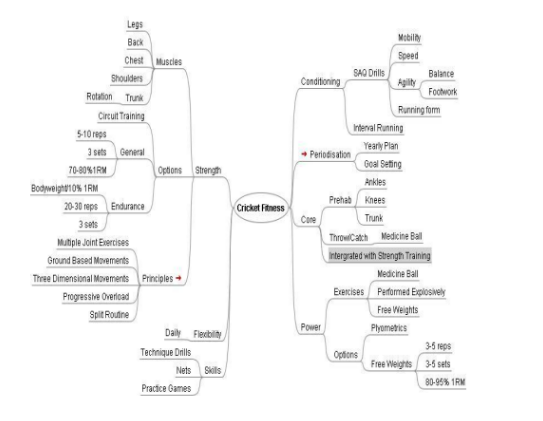CRICKET FITNESS MAP
Rules For Cricket Fitness
= Recovery. Rest is vital for good training. Fitness improvements occur between training sessions, not during them. Amount and type of rest have always been an area of debate but everyone agrees on the importance of getting enough.
=Periodization. The idea that your training needs to be split into 'cycles' depending on your goals and the time of year is long-established and proven to work. Coaches use different techniques, with some dismissing the approach altogether. A simple way to approach periodization can be found in my post on planning your training.
= Fast Twitch Training. Recent research has begun to back the theory that slow training (like long runs) makes slow athletes. This is because power sports such as cricket require short-burst activities that use the fast part of your muscles (fast-twitch fibers). If you train the slow-twitch part you get better at doing stuff slowly. So train in the way you play: with fast, powerful movements.
= Kinetic Chain Theory. This theory makes sense but has been hard to prove. The idea is that your brain controls your body through whole movements and not individual muscles (true). The theory is that in order to train effectively you should forget trying to make individual muscles better/stronger and instead train movements. That way you will be more powerful and faster in the right way.
= Individual Difference. Everyone responds to the same training in the same way but at different levels depending on your age, fitness, medical history and genetics. While this is true, there is no need to worry too much about it as long as you are following the progressive overload principle. It's just some people will need less time to get to the same place than others. Combine these golden rules with the rest of the principles of cricket fitness and you have a rock-solid base of knowledge. You can use these ideas to train yourself better and make yourself a golden cricketer.
Fitness for Cricket - First Steps
The fitter you are the better you play (and the more healthy you are), but where do you start in the quest to getting fit for cricket? Initially the best way is to concentrate on building a baseline of fitness in the gym (In fact, if you aim to play at a serious level this is essential). For example, you could use the basic fitness programmed given to you when you join any gym and see quick improvements (especially if you are just starting out). However, you may want to make your basic gym work specific to building
fitness for cricket. The aim here is to build a foundation of fitness (which can be built on if you desire). It is suitable for anyone wanting to start a programmed of fitness to improve their game or for people returning to training after an injury or long rest period.
Underlying Principles for Cricket Fitness
Before we get to the routine, let's examine the principles it is built on:
Overload to Progress. In order to improve performance, your body needs to be overloaded slightly more than it is used too. That's why lifting heavy weight makes you stronger and running makes you fitter. What this also means is that you constantly need to be reviewing your workout to ensure you are overloading your muscles. They quickly adapt to the stresses of a workout. You also need to rest your body to give it time to adapt.
Reverse. Just as your muscles adapt to increased load, the adaptation will reverse as soon as you stop working out.
Specific. Training is very specific. For example, strength training does not improve endurance. So even at this early stage where the focus is on general fitness we need to consider cricket specific aims. For this reason, all training should be done at a consistent pace with as little rest as possible and exercises must focus on the muscles that you use while playing.
Free weights. Ideally you should use free weights rather than machines for these workouts. However if you are a beginner, using machines is safer and often easier. If you can learn the free weight techniques from your gym then take the chance as free weights give a better overall workout.
Periodisation. While this is a good programmed for any time of the year, if you are planning to build up from this base further the best time to do this is during the off season. In the UK the months from October to December are best, but you can start as early as September.
Safety. This is recommended routine only and you undertake it entirely at your own risk. You are responsibility for your own health and safety. If you are not experienced in the gym a qualified instructor should supervise you. You must consult a doctor before starting any training programmed. I am not a doctor and cannot advise you on this.




0 Comments